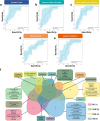Discovery of urinary biosignatures for tuberculosis and nontuberculous mycobacteria classification using metabolomics and machine learning
- PMID: 38961191
- PMCID: PMC11222504
- DOI: 10.1038/s41598-024-66113-x
Discovery of urinary biosignatures for tuberculosis and nontuberculous mycobacteria classification using metabolomics and machine learning
Abstract
Nontuberculous mycobacteria (NTM) infection diagnosis remains a challenge due to its overlapping clinical symptoms with tuberculosis (TB), leading to inappropriate treatment. Herein, we employed noninvasive metabolic phenotyping coupled with comprehensive statistical modeling to discover potential biomarkers for the differential diagnosis of NTM infection versus TB. Urine samples from 19 NTM and 35 TB patients were collected, and untargeted metabolomics was performed using rapid liquid chromatography-mass spectrometry. The urine metabolome was analyzed using a combination of univariate and multivariate statistical approaches, incorporating machine learning. Univariate analysis revealed significant alterations in amino acids, especially tryptophan metabolism, in NTM infection compared to TB. Specifically, NTM infection was associated with upregulated levels of methionine but downregulated levels of glutarate, valine, 3-hydroxyanthranilate, and tryptophan. Five machine learning models were used to classify NTM and TB. Notably, the random forest model demonstrated excellent performance [area under the receiver operating characteristic (ROC) curve greater than 0.8] in distinguishing NTM from TB. Six potential biomarkers for NTM infection diagnosis, including methionine, valine, glutarate, 3-hydroxyanthranilate, corticosterone, and indole-3-carboxyaldehyde, were revealed from univariate ROC analysis and machine learning models. Altogether, our study suggested new noninvasive biomarkers and laid a foundation for applying machine learning to NTM differential diagnosis.
Keywords: Diagnostic biomarkers; Differential diagnosis; Machine learning; Metabolomics; Nontuberculous mycobacteria; Tuberculosis.
© 2024. The Author(s).
Conflict of interest statement
The authors declare no competing interests.
Figures




Similar articles
-
Multiomics and Machine Learning Identify Immunometabolic Biomarkers for Active Tuberculosis Diagnosis Against Nontuberculous Mycobacteria and Latent Tuberculosis Infection.J Proteome Res. 2025 Aug 1;24(8):3783-3797. doi: 10.1021/acs.jproteome.4c00989. Epub 2025 Jul 1. J Proteome Res. 2025. PMID: 40598791
-
Urine lipoarabinomannan point-of-care testing in patients affected by pulmonary nontuberculous mycobacteria--experiences from the Danish Cystic Fibrosis cohort study.BMC Infect Dis. 2014 Dec 4;14:655. doi: 10.1186/s12879-014-0655-4. BMC Infect Dis. 2014. PMID: 25471640 Free PMC article. Clinical Trial.
-
A Two-Step Real-Time PCR Method To Identify Mycobacterium tuberculosis Infections and Six Dominant Nontuberculous Mycobacterial Infections from Clinical Specimens.Microbiol Spectr. 2023 Aug 17;11(4):e0160623. doi: 10.1128/spectrum.01606-23. Epub 2023 Jun 28. Microbiol Spectr. 2023. PMID: 37378523 Free PMC article.
-
Of tuberculosis and non-tuberculous mycobacterial infections - a comparative analysis of epidemiology, diagnosis and treatment.J Biomed Sci. 2020 Jun 17;27(1):74. doi: 10.1186/s12929-020-00667-6. J Biomed Sci. 2020. PMID: 32552732 Free PMC article. Review.
-
Interrelational changes in the epidemiology and clinical features of nontuberculous mycobacterial pulmonary disease and tuberculosis in a referral hospital in Japan.Respir Med. 2019 Jun;152:74-80. doi: 10.1016/j.rmed.2019.05.001. Epub 2019 May 8. Respir Med. 2019. PMID: 31128614 Review.
Cited by
-
Gut microbiota and tuberculosis.Imeta. 2025 Jun 22;4(4):e70054. doi: 10.1002/imt2.70054. eCollection 2025 Aug. Imeta. 2025. PMID: 40860431 Free PMC article. Review.
-
Multimodal machine learning-based model for differentiating nontuberculous mycobacteria from mycobacterium tuberculosis.Front Public Health. 2025 Feb 17;13:1470072. doi: 10.3389/fpubh.2025.1470072. eCollection 2025. Front Public Health. 2025. PMID: 40034169 Free PMC article.
References
Publication types
MeSH terms
Substances
Grants and funding
LinkOut - more resources
Full Text Sources
Medical

